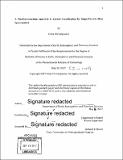| dc.contributor.advisor | David McGee. | en_US |
| dc.contributor.author | Christopoulos, Costa (Costa D.) | en_US |
| dc.contributor.other | Massachusetts Institute of Technology. Department of Earth, Atmospheric, and Planetary Sciences. | en_US |
| dc.date.accessioned | 2018-04-27T18:11:08Z | |
| dc.date.available | 2018-04-27T18:11:08Z | |
| dc.date.copyright | 2017 | en_US |
| dc.date.issued | 2017 | en_US |
| dc.identifier.uri | http://hdl.handle.net/1721.1/115038 | |
| dc.description | Thesis: S.B., Massachusetts Institute of Technology, Department of Earth, Atmospheric, and Planetary Sciences, 2017. | en_US |
| dc.description | Cataloged from PDF version of thesis. | en_US |
| dc.description | Includes bibliographical references (pages 21-26). | en_US |
| dc.description.abstract | Compositional analysis of atmospheric and laboratory aerosols is often conducted via single-particle mass spectrometry (SPMS), an in situ and real-time analytical technique that produces mass spectra on a single particle basis. In this study, machine learning classification algorithms are created using a dataset of SPMS spectra to automatically differentiate particles on the basis of chemistry and size. While clustering methods have been used to group aerosols into broad categories based on similarity, these models do not incorporate known aerosols labels and are not explicitly formulated for classification. Furthermore, traditional methods often rely on a smaller set of well-known, important variables whereas the proposed method is more general and flexible, allowing researchers to automatically quantify and select important variables from any aerosol subset. In this work, machine learning algorithms build a predictive model from a training set in which the aerosol type associated with each mass spectrum is known. Several such classification models were created to differentiate aerosol types in four broad categories: fertile soils, mineral/metallic particles, biological, and all other aerosols using -40 common positive and negative spectral features. For this broad categorization, machine learning resulted in a classification accuracy of -93%. More complex models were developed to classify aerosols into specific categories which resulted in a classification accuracy of -87%. The trained model was then applied to a 'blind' mixture of aerosols with model agreement on the presence of secondary organic aerosol, coated and uncoated mineral dust and fertile soil. Additionally, the model is used to characterize an ambient atmospheric dataset collected from the free troposphere. | en_US |
| dc.description.statementofresponsibility | by Costa Christopoulos. | en_US |
| dc.format.extent | 29 pages, 11 unnumbered pages | en_US |
| dc.language.iso | eng | en_US |
| dc.publisher | Massachusetts Institute of Technology | en_US |
| dc.rights | MIT theses are protected by copyright. They may be viewed, downloaded, or printed from this source but further reproduction or distribution in any format is prohibited without written permission. | en_US |
| dc.rights.uri | http://dspace.mit.edu/handle/1721.1/7582 | en_US |
| dc.subject | Earth, Atmospheric, and Planetary Sciences. | en_US |
| dc.title | A machine-learning approach to aerosol classification for single-particle mass spectrometry | en_US |
| dc.type | Thesis | en_US |
| dc.description.degree | S.B. | en_US |
| dc.contributor.department | Massachusetts Institute of Technology. Department of Earth, Atmospheric, and Planetary Sciences | |
| dc.identifier.oclc | 1031985395 | en_US |

